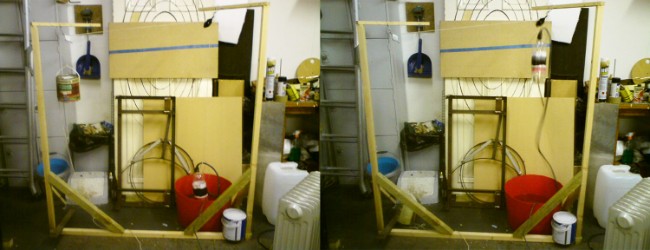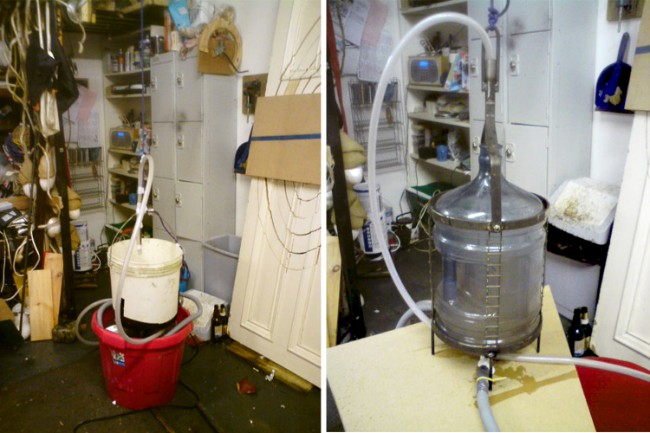Hydraulic Counterweight
In October 2011 Oliver Braid asked me if it was possible to create a device for raising and lowering a pair of pink felt blinds that were to form part of his New Work Scotland Collective Christmas Window Display in Cockburn Street, Edinburgh. This was a tempting offer, one whose outcome was deceptively simple. No mechanism existed off-hand to answer the question.
I immediately and somewhat optimistically said yes, then realised the difficulty of the task and hurriedly set about trying to answer the conundrum. The blinds were to be the size of Collective’s two adjoining street-front windows – each four metres wide by three metres high. When closed the blinds form a giant pair of eyelids, complete with lashes of black plastic drinking straws. Upon retracting, a giant set of card eyeballs, replete with hand-cut coloured card veins, would be revealed. A television monitor in each pupil would present text and animation by another collaborator to the work (The collaborator count would eventually make five). The blinds would need to open and shut continuously and faultlessly for three weeks spanning two years – entertaining the Christmas crowds in December and distracting the sales moshpit in January.
First Problem: What power source do I use, and how do I transmit the energy from this to some sort of winding device? Second Problem: Duty Cycle – most motors cannot run 100% of the time, they must stop every now and then to avoid overheating. Therefore, whatever powered the blinds must stay off occasionally, or alternatively their ‘off’ state is incorporated into the mechanisms’ cycle. Third problem: The blinds were substantial, and their up and down movement requiring something to reduce friction. This is easily solved with pulleys or bearings, but particular pulleys for this peculiar job would need to be sourced. Fourth Problem: mounting the device and the blind together in situ at Collective Gallery. The whole assembly would need to be modular and easily assembled.
Back in studio 36, our trusty windscreen wiper motors were picked off the shelf, held in hand in contemplation, then reinstalled back on the shelf, their torque being too low. A cycle chain and freewheel cog were assembled in a hope their ratcheting one-way drive mechanism could be exploited. It couldn’t. A 400-watt vehicle winch was priced up, but dismissed because of the complication of relays and switches, not to mention that its power consumption may eventually have melted my cheap DIY electronics. Stage weights were posited, acting as counterweights for the weight of the blind. This was the best grasp into the dark yet, and the only one of these ideas that I pursued.
The method of offsetting an object’s weight with that of another has been exploited since 2000 BC with the Shadoof, or counterpoise, as an irrigation tool. A water scoop sits at the opposite end of a beam to a counterweight - the beam pivots in the centre, enabling a person to lift a far greater volume of water than they could by hand. The word Shadoof oiginates from an Arabic word, and the device is still in use today in parts of Africa. I have always admired these sort of simple yet highly effective tools, and began to wonder if certain aspects of this method could be used for my own problem.
For I understand that this project could have been solved with silently powerful motors and gleaming electronics featuring timers and relays. It could have been wired up to a Mac, and have been remotely monitored, turned off and on, on a whim. These are all possibilities, but there are limitations to a project – one is always the budget, but the other is my own disposition for using real objects and experiencing their reaction to other objects in the world. My mechanism would be truly mechanical – utilising the properties of materials and principles of physics, and reduced to the simplest design possible.
Among the artist-engineer types that I admire are Dutch Strandbeest creator Theo Jansen, Arthur Ganson – an American sculptor constructing his own cogs and gears from brazed wire, and of course the fathers of modern kinetic art such as Lazlo Moholy-Nagy and Jean Tinguely. Equally influential is Tim Hunkin – bespoke arcade-game maker, cartoonist and engineer. Situated in the town of Southwold, Suffolk, Hunkin is a great problem-solver and researcher, many of whose works are in permanent collection under Southwold Pier. His website www.timhunkin.com is a fascinating resource for over thirty years of garden shed tinkering and of the most unlikely and ingenious stretches of imagination.
I began to recall seeing Hunkin’s 1975 work Birth of Venus on his website a few years ago. This was a coin-operated peep-show device displayed in Camden Lock, London, in which a folding image of model Raquel Welch emerged from a bath of coloured water when a coin was inserted to the slot. The payment activated a water pump that raised water from the bath to a bucket above. When full the bucket tipped into a large cullender, whose extra weight pulls down on a rope, revealing the image. As the water leaked back to the bath, the cullender rose and the image vanished back into the murky water, to be enticed out again by a new monetary deposit.
My thoughts also arrived at a method of storing energy in water on an industrial scale – pumped-storage hydroelectricity, an example of which is the Cruachan Dam Power Station in Argyll, Scotland. Two levels of water storage are required, which in this case are an upper reservoir and Loch Awe. In times of normal electricity usage, water remains in the lower reservoir, but when supply exceeds demand, the excess electricity is used to pump the water from the lower to the upper reservoir. When this electricity is required once more the water flows back downhill, turning impellers that generate electricity for the grid. I find this transformation of electrical energy to a liquid mass then back again an elegant solution for energy storage, and one that would inspire my own solution to the blind problem.

So I now had the impetus from which to fashion my own device: a blind-winder on a never-ending cycle. I would use water as a variable counterweight, the water would be pumped upwards to a container that was connected via rope and pulleys to the blind, then it would slowly trickle back to the original container, lowering the blind and beginning the cycle again. Time to start building: Device Number One was a fizzy drink bottle, filled by a 12-volt caravan shower pump. It lifted a half-full paint pot a few feet high, most of the time. Device Number Two was suspended from the studio roof beams: the caravan pump now filled a yacht bouy, slowly, until it lifted a bucket full of weights and water. If the pump stayed on too long a jet of water would squirt out, saturating anything in its path. If the bouy’s water leaked out too quick, the bucket would crash to the floor, again saturating anything in the vicinity. The studio just got wetter, but the devices began to refine.
It was time to upgrade the pump to something with more power, and to address the issue of how to switch off the pump once the container was full, and restart it once the water had drained back to the bucket. A cellar pump with a float switch answered both these problems. The switch was attached to a pivoting mount to ensure it turned off and on precisely in the water. Oliver came to see the set-up and was taken by the way the water could appear like tears falling from the giant eyes. I needed to find a large transparent water container that could act visually as a tear, and found it in two 18-litre office water-cooler bottles. Extendable vacuum cleaner hoses transfer the run-off from these bottles to the pink tubs below, ensuring the water stayed within the containers and not everywhere else.

So that was it – after much filling and draining of containers, buckets and bouys; of standing and watching for faults; of daily plunging my hands into almost-freezing water (yes, I know it was a crazy idea to build a water sculpture in the middle of winter. In Scotland.), the whole set-up worked rather well, and once one was made, I then built the whole thing again for the other eye! I like to think that with the external impetus of electricity my otherwise self-sustaining mechanisms exist in their own energy twilight zone, one in which they never find a stable equilibrium, and therefore perpetuate a cycle – the float switch in the full tub of water jolts the pump to drain the water upwards to the water cooler; the heavy full cooler slowly brings up the blind (which has its own set of counterweights to equal that of the water), but slowly loses its water and its weight; the water is returned to the tub, lowering the blind, until the float switch once again activates the pump, beginning the cycle once more. Oliver’s question had been answered, and I had completed a real eye-opener of a project!